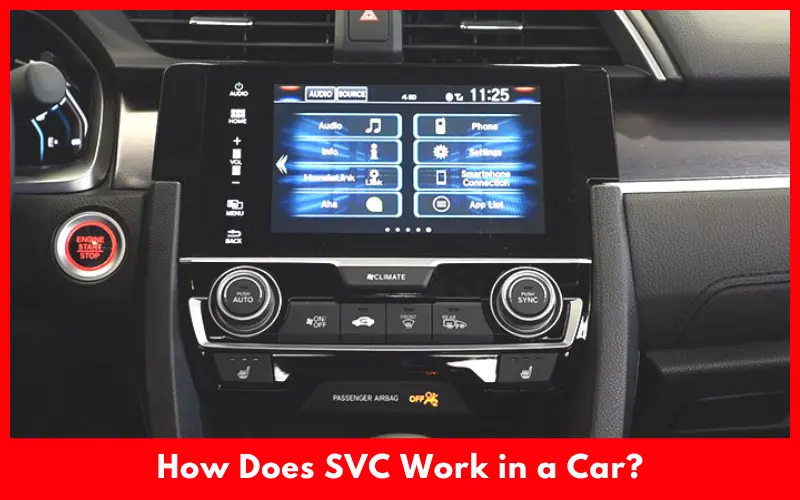You may have noticed the SVC function in your car’s audio setting and wondering what does SVC mean in a car. But have you ever wondered how you can enjoy the best sound quality during driving even at high speed or in high traffic? Thanks to your car’s SVC function.
SVC is an important part of a modern car’s audio system that adjusts the volume based on the driving speed. Hence you can enjoy clear and satisfying music or radio even in noisy or windy places. You can also adjust the SVC’s sensitivity level and deactivate it if your car allows it.
Article Summary
What Does SVC mean in A Car?
SVC (Speed Volume Compensation) is a feature of the radio system of a car that adjusts the audio volume according to the speed. Most modern car has this function that helps hear the music instead of the engine or wind’s growing noise.
The SVC uses a car’s speedometer to measure the speed and take average readings for a certain period. So if you drive fast, the volume will increase while driving slowly will reduce the volume. But if you drive the car at a constant speed and don’t press the acceleration pedal, the volume won’t change.
This function is helpful, particularly in crowded places and traffic jams where the car’s speed changes frequently. Apart from automatic adjustment, SVC also allows changing the mode from OFF to High based on the situation and needs.
How Does SVC Work in A Car?
SVC works by adjusting the radio volume following the vehicle’s speed. It keeps the noise-to-radio ratio of the cabin at a comfortable level along with the increase or decrease of acceleration. SVC systems usually turn on at speeds over 35 mph which varies depending on the car or audio system’s manufacturer.

The working principle of the SVC system also varies depending on the type of radio system. While stock radio control the volume automatically depending on the vehicle’s speed and cabin’s ambient noise, aftermarket radios only depend on cabin noise.
Stock radio uses the same microphone as hands-free calling. But aftermarket radios contain special microphones to determine the cabin noise. Based on your car or radio manufacturer, you should be able to deactivate this function to adjust the sensitivity level.
Speed-compensated volume has three adjusting levels that you can set based on the situation.
- Low: suitable for a quiet environment like driving in a city where noise is minimal.
- Mild: used on a moderately noisy area like a highway.
- High: used in highly noisy areas like high-traffic areas.
How To Deactivate or Adjust The SVC?
If you don’t let the SVC adjust the music sound automatically, you can deactivate it. Though the deactivating and adjusting process of SVC varies depending on the car’s make and model, below is the most common method:
Simply go to the menu or setting option on your car’s display by touching it or using the control buttons. Scroll down and select the Sound option and then SVC. You should have now four adjusting options like
- SVC OFF
- SVC LOW
- SVC MID
- SVC HIGH
Selecting OFF will deactivate the SVC. But if you want to adjust the sensitivity of the system, select the other three options based on your preference. Some vehicle models also allow adjusting the SVC setting between off and +7.
After deactivating the SVC, you’ll need to adjust the volume manually depending on the road condition, wind, and cabin noise.
Will You Get Better Sound If You Turn Off SVC?
Since the SVC adjusts the sound level continuously depending on the car’s speed, many people decide to deactivate it in search of better sound quality. But will you really get better sound after turning off the SVC or it will cause havoc?

The experience varies from person to person. Some people may love the music sound after deactivating the SVC. But most people love consistent music sound, that’s where SVC plays its role. This system makes sure you enjoy clear radio or music sound all the time even if you are in a crowded or noisy place.
Turning off the SVC may provide you with better sound in a quiet area. But you have to adjust the volume frequently while driving which is risky as well. Hence automobile manufacturers invented SVC to let you focus on driving while enjoying the better sound. However, you can experiment with it by driving in both conditions and determining which option is better for you.
What to do if SVC doesn’t Work Properly?
Your car’s SVC system may malfunction due to plenty of reasons including operational error, bad module, or dysfunctional SVC. If the SVC is turned off in your car, you may need to activate it again.

But if your car’s SVC system is non-adjustable, you have to fix the problem by diagnosing the ACM modules and determining the damaged components. You may also need to reprogram the SVC to restore its functionality.
Some Advantages and Disadvantages of SVC in a Car
Below are some pros and cons of having SVC in a car so you can decide whether you should use it or deactivate it:

Advantages
- It adjusts the volume automatically as you accelerate to eliminate the need for manual adjustment.
- The function helps create less messy sounds inside the car.
- Allow to keep the focus on driving and keep hands on the steering wheel instead of concentrating on the sound level.
- Automatically reduce the music volume while reducing the car speed to avoid hearing blaring noise after deceleration.
- The SVC has plenty of adjusting levels to allow the driver to choose the most comfortable setting based on the environment.
Disadvantages
- The SVC can’t make the volume loud enough for some drivers’ preferences.
- It delays the volume adjusting process which becomes more noticeable when changing the speed rapidly.
- SVC function isn’t available in all cars’ audio systems and doesn’t come as a standard feature in some cars.
Related Article: What Does DTE Mean in A Car
FAQs
Does SVC make the volume louder?
SVC modifies the volume depending on the speed of the vehicle. If the vehicle moves faster, it’ll increase the volume automatically.
What’s the difference between SVC and ASL?
SVC (Speed Compensated Volume) and ASL (Automatic Sound Leveling) are used for quite the same purpose. While SVC adjusted based on the car’s speed, ASL modified the detecting noise level inside and outside of the car. The ASL feature is a part of the JBL infotainment system found on Toyota cars that uses three microphones to detect noise.
What Does SSV mean in a car?
SSV (speed-sensitive volume) means increasing the car’s sound system depending on the speed. It also uses a microphone to monitor the noise level inside the cabin and automatically adjust the volume accordingly.
Final Words
Now you should understand what does SVC mean in a car and why this function is important. However, its performance might not please all the drivers. So, if your car allows you to turn off and adjust the level, try all the possibilities to find the most comfortable level. But if it doesn’t, try to be comfortable to enjoy the best music quality even at fast speed or in high traffic.

